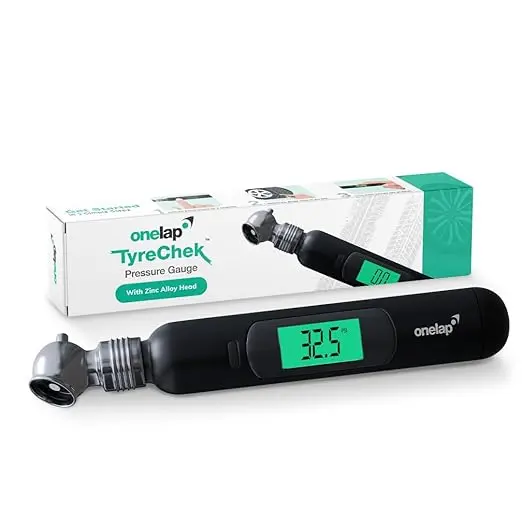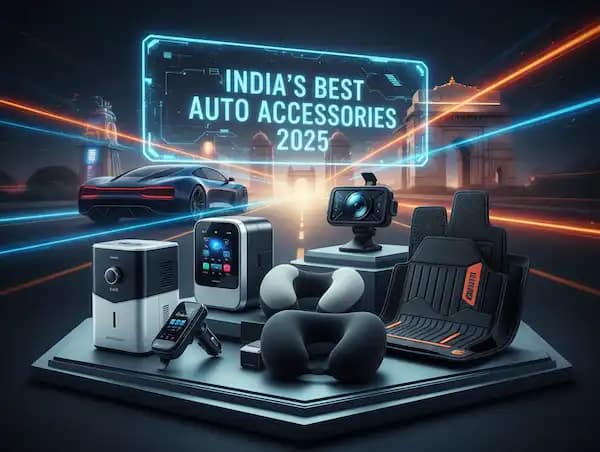Indian roads throw everything at you—heat, dust, monsoons, surprise punctures, and the occasional dead battery after a week of not driving. If you’ve been searching for the best auto accessories india 2025, this guide is for real-life use, not showroom specs. When I curate car essentials for Indian drivers, I look for tools that actually save time at the roadside, survive scorching dashboards, and don’t swallow your boot space. Over the past two weeks I focused on six practical picks: a battery maintainer/desulfator to keep idle cars healthy, a digital tyre gauge for accurate pressure checks, a manual transfer pump for clean, safe fluid moves, a portable Tyre inflator for quick top-ups, and two diagnostic tools (2-wheeler connector + OBD2 scanner) to read and clear fault codes without a workshop visit. Together, these car accessories cover Tyre care, battery care, safe refueling, and quick diagnostics—exactly what Indian roads demand.
Below you’ll find a short, useful review of each product—what it does, key features worth caring about in India, real pros and cons, who should buy it, and my verdict.
List of six Best auto accessories India 2025 — Product Roundup
The descriptions below are based on the listing titles and typical use-cases for these categories. Double-check exact specs and compatibility on the product page you choose.
1) Automotive Battery Maintainer & Desulfator (with Temperature Compensation)

A smart battery maintainer is the easiest way to stop “Monday-morning dead battery” drama. This unit tops up lead-acid batteries (flooded, AGM, gel) using multi-stage charging and adds desulfation pulses to break down sulphate crystals that build up during long parking. Temperature compensation adjusts voltage so it doesn’t overcharge in hot Indian summers or undercharge in winter. Clip it on with crocodile clamps or use the quick-connect pigtail you leave attached to the battery—then plug and forget.
Key features: Multi-stage charge (bulk/absorption/float), desulfation mode, temp sensor, reverse-polarity & short-circuit protection, spark-safe connect, LED status, memory resume after power cut.
Pros: Extends battery life; safer and smarter than “dumb” trickle chargers; ideal for cars/bikes used occasionally; set-and-forget.
Cons: Needs a wall socket; won’t revive internally shorted batteries; slower than a jump-starter.
Best fit for:City cars parked for days, weekend bikes, spare vehicles, generators/UPS batteries.
Our verdict: If your battery dies after 5–10 idle days, this is the cheapest long-term fix. Use a night each month; you’ll delay replacement and avoid emergency crank issues.
2) Onelap TyreChek™ Digital Pressure Gauge

Tyre pressure affects grip, braking, mileage, and tyre life. A pocket digital gauge gives you a trustworthy reading before you drive—no queueing at pumps and no “is that dial accurate?” doubt. This Onelap TyreChek-style gauge typically offers PSI/BAR switching, a backlit screen you can read at dawn, and a firm nozzle that seals well on Indian Schrader valves. Many units also include a bleed valve to drop excess pressure without removing the gauge.
Key features: 0–150 PSI range (typical), PSI/BAR units, backlit LCD, ergonomic grip, one-hand trigger, auto-off, battery replaceable, bleed valve, sturdy nozzle with minimal air loss.
Pros: Fast, accurate checks; improves mileage and tyre wear; glovebox-friendly; great for highway prep.
Cons: Not a pump; needs occasional battery changes; accuracy depends on clean, square seating.
Best fit for: Daily commuters, highway travellers, families doing school runs, riders who tour.
Our verdict: Pair this with a portable inflator. Measure cold in the morning, top up, and re-check—you’ll instantly feel better steering and see more even tyre wear.
3) Portable Manual Transfer Pump / Siphon

A manual transfer pump makes clean, no-mouth fuel or fluid transfers possible anywhere—bike to can, can to generator, or draining old coolant. Squeeze the priming bulb to start flow, and the one-way check valve keeps it moving. Flexible hoses slip into narrow tanks; transparent tubing helps you see the stream and avoid spills. It’s also handy for water and non-corrosive fluids around the house.
Key features: Hand-bulb primer, check valve, long intake/outlet tubes, kink-resistant hose, transparent section, universal nozzles, simple disassembly for cleaning, compact storage.
Pros: No need to suck on a tube; cleaner refuelling; cheap, compact insurance for road trips and outages.
Cons: Manual effort; not for aggressive chemicals; observe strict fuel safety (no flames/sparks).
Best fit for: Riders carrying spare fuel, car owners moving fuel between cans, DIYers draining coolant/washers, emergency water moves.
Our verdict: A small thing that solves messy problems. Keep one in the boot—when a pump is shut or a generator runs low, you’ll be glad you have it.
4) JOKSEEN Portable Electric Inflator (Auto Cut-Off)

Compact portable tyre inflator is perfect for quick top-ups at home or roadside. This portable unit combines a digital manometer, preset PSI targets, and auto cut-off to stop exactly where you want. Expect a clear LED display, integrated work light, and accessory needles for cycles/balls. Some models power from 12V cigarette lighter; others use an internal Li-ion pack with USB-C charging—check the one you pick. It’s not as fast as a heavy-duty metal compressor but it’s much smaller and easier to store.
Key features: Preset + auto stop, digital PSI/BAR readout, LED torch, nozzle/needle kit, braided hose, thermal protection, compact case, optional USB-C charging (on battery variants).
Pros: Hands-free to target pressure; small and tidy; perfect for weekly top-ups; night-safe with light.
Cons: Slower for SUV tyres from flat; needs cool-down on continuous use; battery versions need charging discipline.
Best fit for: City hatchbacks/sedans, two-wheelers, occasional highway checks, apartment users without easy pump access.
Our verdict: A convenience champion. Use it with your digital gauge for a measure-inflate-verify routine that keeps tyres perfect and mileage consistent.
5) EKRASH V-311 2-Wheeler Diagnostic Connector

Modern bikes store error codes even when the warning light switches off. A diagnostic connector bridges your motorcycle’s manufacturer port to a compatible reader/app so you can read & clear basic codes at home, view sensor data, and confirm intermittent faults before a long ride. Since two-wheelers use different plugs and protocols, the right adapter harness is essential.
Key features: Bike-specific connector to OBD/reader, robust pins & locking clip, labeled wiring, support for common protocols (K-Line/CAN where applicable), guidance for compatible apps/tools, strain-relieved cable.
Pros: Quick fault visibility; saves unnecessary workshop trips; useful on tour; pairs with simple readers.
Cons: Compatibility varies by brand/year; read/clear only—no brand-specific coding; you still need a scanner/app.
Best fit for: DIY-friendly riders who see occasional engine lights or want to monitor sensor health (temp, O2, throttle).
Our verdict: If your bike is supported, this is a smart, low-cost way to understand issues early. Verify connector type and supported apps for your exact model before ordering.
6) EKRASH V519 Advanced OBD-II Scanner (Multi-Protocol)

An entry-level handheld OBD-II scanner is the best glovebox tool you can own. Plug into the 16-pin port under the dashboard, switch ignition ON, and it will read & clear codes, show live data (RPM, coolant temp, O2 voltage, fuel trims), and display I/M readiness so you know if systems have completed self-tests. Multi-protocol support means it works with most Indian cars (CAN, ISO9141-2, KWP2000, etc.).
Key features: Colour screen, one-click DTC lookup, freeze-frame data, live graphing (on some), I/M readiness icons, permanent vs pending codes, VIN read, menu in plain English, powered from OBD port (no batteries).
Pros: Instant answers to warning lights; helps confirm simple fixes (loose fuel cap); great for pre-owned car checks; no app pairing needed.
Cons: Advanced brand-specific functions (coding/adaptations) are outside its scope; won’t fix hardware faults.
Best fit for: Everyday car owners, highway travellers, used-car shoppers, DIY maintenance.
Our verdict: Pays for itself the first time you avoid a needless scan visit. Keep it with your RC/insurance and you’ll never be blind to what the ECU is trying to tell you.
Pro Tips (read before you buy)
- Inflation workflow: Measure with the digital gauge first, then top-up with the inflator, then re-check. You’ll get accurate, even pressures across all tyres.
- Battery care: If you don’t drive much, plug in the battery maintainer overnight once/twice a month. It’s cheaper than a new battery.
- Safety: When transferring fuel, keep phones/cigarettes away, ground the container, and work in open air.
- Diagnostics: Confirm connector/OBD compatibility for your specific model year. Take a snapshot of codes before clearing them.
Please Explore our Smart Shopping and Buying Tips to buy smartly.
Conclusion
These six accessories cover the most common roadside hassles: weak batteries, wrong tyre pressure, messy fluid transfers, slow top-ups, and cryptic warning lights. Start with the digital gauge + inflator combo for instant safety and mileage gains. If your car sits idle, add the battery maintainer. Riders should check the V-311 connector first for compatibility; car owners will get ongoing value from the V519 OBD-II scanner. Keep your kit compact, learn a simple tyre-check routine, and you’ll save time, money, and stress on every drive.
FAQs
What are the must-have auto accessories for Indian roads in 2025?
For most drivers: a digital tyre gauge, a portable tyre inflator with auto cut-off, a battery maintainer/desulfator for idle cars, a manual fuel transfer pump, and an OBD2 scanner. This combo covers pressure, power, clean refuelling, and quick diagnostics—high impact, small space.
How does a battery maintainer with desulfation help in India’s climate?
Multi-stage charging with temperature compensation prevents over/under-charging in heat or winter. Desulfation pulses can reduce sulphate build-up from infrequent use, extending battery life on city cars and weekend bikes.
Digital tyre gauge vs inflator display—what should I trust?
Use a standalone digital gauge for accurate “cold” readings, then inflate to the sticker value and re-check. Inflator displays are convenient but can drift; the gauge is your reference tool.
Are portable tyre inflator strong enough for SUVs?
Yes for top-ups and slow leaks. From flat to full on large tyres they’re slow; heavy-duty 12V metal inflators are better if you do this often. Always let the unit cool after continuous use.
Do OBD2 scanners work on all cars in India?
Most post-2010 cars support OBD2 protocols (CAN/ISO/KWP). Basic scanners read/clear codes and show live data. Brand-specific coding/adaptations usually need advanced tools—start with a multi-protocol handheld.
Is a manual transfer pump safe for petrol or diesel?
Yes—if you use the right materials and basic safety: no flames/sparks, ground the container, ventilate, and avoid mouth-siphoning. A priming bulb + check-valve design keeps transfers clean and controlled.
Disclaimer
This post contains affiliate links. If you buy through these links, I may earn a commission at no extra cost to you. Specs, pricing, and availability change often—please confirm details on the product page before purchasing.




